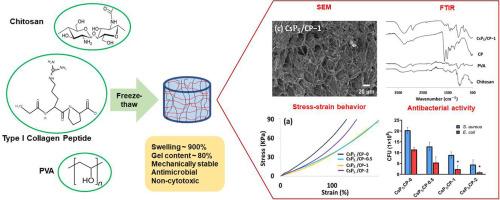评估注入海洋胶原蛋白肽的壳聚糖-PVA 水凝胶在伤口愈合方面的潜在应用
IF 5.3
Q2 MATERIALS SCIENCE, COMPOSITES
引用次数: 0
摘要
理想的伤口敷料应能加强伤口部位的湿度管理、抗菌、物理屏障和机械强度。此外,这种敷料还应该易于在伤口上使用,并具有生物相容性和无毒性。在这项研究中,我们采用了无连接剂冻融程序来制造一系列壳聚糖/PVA 水凝胶,并与市面上的海洋胶原蛋白肽混合。海洋胶原蛋白肽(CP)作为海洋食品工业的副产品很容易获得,是该领域生物材料的一种廉价而新颖的来源。壳聚糖、PVA 和 CP 的不同重量比会影响水凝胶的特性,如溶胀、凝胶含量、蒸发和机械特性。此外,还利用扫描电镜和 ATR-FTIR 对理想条件下生成的水凝胶进行了表征。24 小时后,最佳水凝胶(壳聚糖:PVA:CP 的比例为 1:5:1)的吸水能力高达 900%,凝胶含量为 80%,蒸发率为 40%。ATR-FTIR 光谱验证了海洋胶原蛋白肽和凝胶形成成分之间的物理相互作用,水凝胶保持了足够的多孔结构,可用于伤口敷料。为了测试水凝胶的机械完整性,进行了压缩测试,结果显示压缩模量高达 40 千帕。在壳聚糖/PVA 水凝胶中添加海洋胶原蛋白肽可提高其润湿性、抗菌能力和止血性能。此外,该水凝胶的制备过程简单,不使用有毒化学物质,是开发安全有效的水凝胶伤口敷料的典范。本文章由计算机程序翻译,如有差异,请以英文原文为准。

Assessment of chitosan-PVA hydrogels infused with marine collagen peptides for potential wound healing applications
Ideal wound dressings should show enhanced moisture management at the wound site, antibacterial and physical barrier, and mechanical robustness. Additionally, it should be easy to apply to the wound and be biocompatible and non-toxic. In this study, a linker-free freeze-thaw procedure was used to create an array of chitosan/PVA hydrogels blended with commercially available marine collagen peptides. Marine collagen peptides (CP) are easily available as by-products of the marine food industry and are an inexpensive and novel source of biomaterial in this field. The different weight ratios of chitosan, PVA, and CP influenced the hydrogel properties such as swelling, gel content, evaporation, and mechanical properties. Furthermore, SEM and ATR-FTIR were used to characterize the hydrogels generated under ideal conditions. After 24 h, the optimum hydrogel (chitosan:PVA:CP ratio of 1:5:1) showed a water absorption capacity of up to 900 %, a gel content of 80 %, and a 40 % evaporation rate. The physical interactions between marine collagen peptide and gel-forming components were validated by ATR-FTIR spectra, and the hydrogel kept a sufficient porous structure for potential wound dressing application. To test the mechanical integrity of the hydrogels, compression testing was carried out showing a compressive modulus of up to ∼40 kPa. The addition of marine collagen peptide in the chitosan/PVA hydrogel increased its wettability, antimicrobial capabilities, and hemostatic properties. Furthermore, the hydrogel preparation procedure is simple and does not use toxic chemicals, serving as a model for developing safe and effective hydrogel wound dressing.
求助全文
通过发布文献求助,成功后即可免费获取论文全文。
去求助
来源期刊

Composites Part C Open Access
Engineering-Mechanical Engineering
CiteScore
8.60
自引率
2.40%
发文量
96
审稿时长
55 days
 求助内容:
求助内容: 应助结果提醒方式:
应助结果提醒方式:


